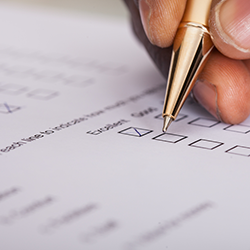 The procurement process often consists of a number of common steps, each broken down into smaller process-specific tasks. Whether you’re new to procurement and contract administration or you’ve been doing it for years, it pays to follow a methodology rather than relying purely on memory.
The procurement process often consists of a number of common steps, each broken down into smaller process-specific tasks. Whether you’re new to procurement and contract administration or you’ve been doing it for years, it pays to follow a methodology rather than relying purely on memory.
Repeatability and compliance
In public procurement it’s all the more important to operate methodically and keep a track of your actions. This substantially reduces the potential for accusations of bias, or questions of credibility. Suggestions such as these can have wider repercussions than merely tarnishing personal reputations, possibly casting aspersions on the integrity of the entire body.
Of course, practice makes perfect. Your experience of managing procurement processes will inform your knowledge and improve your reliability. In fact, this kind of reflection on how your procurement function is operating is essential to achieving the best results. Through this experience your procurement checklist will become more comprehensive and robust.
Why use procurement checklists
You might be managing procurement exercises at part of a team, shadowing a manager or being overseen by seniors. In these instances, numerous individuals will inform the process, increasing its accuracy, efficiency and reliability. If this is the case, having a checklist gives you helpful backup to make sure nothing is missed.
If you’re tasked with managing procurement processes yourself you can see the checklist as a way of passing on your experience and helping ensure everyone is ‘on the same page’.
Fail to plan and you plan to fail…
When managing your first procurement processes it may seem onerous and time-consuming to plan and monitor steps and actions. But you’ll reap the benefits in time. Reinventing the wheel from scratch at the commencement of each procurement programme is where the real time is wasted.
A generic checklist combined with the experience you’ve gained puts you on the front foot immediately, and provides a strong basis for future procurement projects. At a high level the procurement process looks like this but should be tailored to your own circumstances.
- Identify requirements
- Develop the specification
- Market research
- Planning and scheduling the procurement process
- Request proposals
- Evaluate supplier offers
- Award the contract
- Manage the contract
Checklists are the basis for procurement workflow
One of the key benefits of next-generation procurement systems is their ability to operate workflow. Workflow allows each procurement entity (whether a team, department or organisation) to have its own processes embedded in the eProcurement system. This acts as a master checklist and can be set-up to ensure that specific steps are followed, even stipulating that they must be followed in a particular order. To get the most out of workflow, having a clear view of your procurement checklist is the perfect place to start.

